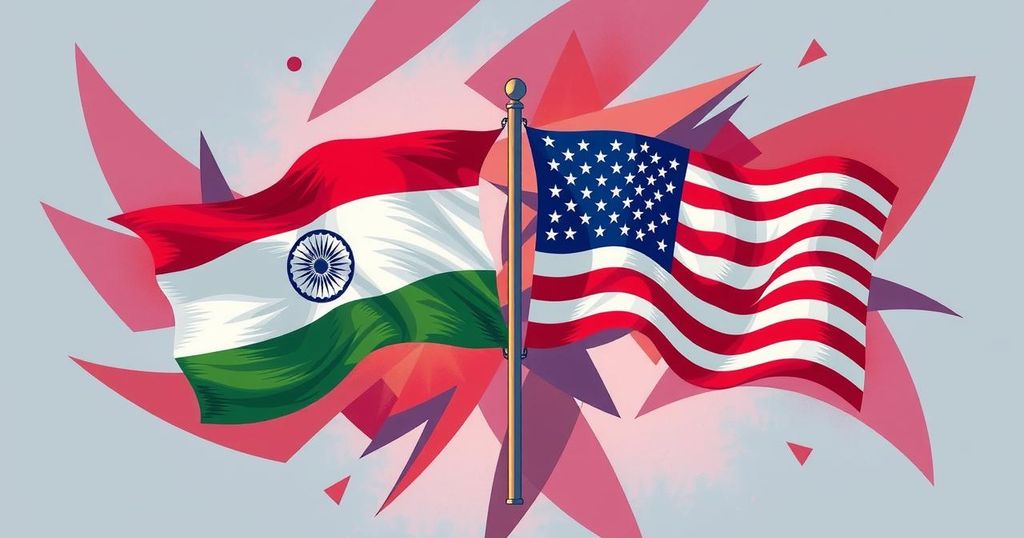economics
AMERICA, ASIA, BANGKOK, CHINA, DONALD TRUMP, ECONOMICS, EU, EUROPEAN UNION, INDIA, JAPAN, MEXICO, MODI, NA, NARENDRA MODI, NATIONAL SECURITY, NEW DELHI, NORTH AMERICA, ROSE GARDEN, THAILAND, TRADE, TRUMP, UK, UNITED STATES, US, US-CHINA RELATIONS, WASHINGTON, WHITE HOUSE
Fatima Khan
0 Comments
Trump Imposes 26% Tariff on Indian Imports Amid Trade Disputes
President Donald Trump has implemented a 26% “discounted reciprocal tariff” on all imports from India as part of his broader plan to combat unfair trade practices from 60 countries. This tariff is positioned to be significantly lower than those imposed by these nations, though the rationale behind the figures was unclear. There are concerns the tariffs may spur trade wars that could adversely affect the global economy.
On Thursday, President Donald Trump announced a 26% “discounted reciprocal tariff” on all imports from India, as part of his administration’s punitive measures against 60 countries with significant trade barriers against American goods. This decision is part of Trump’s “Liberation Day” initiative designed to balance international trade and enhance domestic manufacturing.
In his address at the White House’s Rose Garden, Trump elaborated that this tariff is set at half the rates imposed by the targeted countries, which include India, China, Japan, the United Kingdom, and members of the European Union. However, the methodology used to calculate these tariffs was not clearly outlined.
Trump emphasized the disparity in tariff rates, noting that while the US applies a 2.4% tariff on motorcycles, India charges a staggering 70%. He expressed concerns over trade practices by India and referred to a prior visit from Indian Prime Minister Narendra Modi, stating that despite their friendship, India has not treated the US favorably regarding tariffs.
The Indian government is anticipated to respond to these tariffs later today, although Prime Minister Modi is currently en route to Thailand for the Bimstec Summit. During a previous meeting in February, Modi and Trump set ambitious trade goals, intending to double bilateral trade to $500 billion by 2030, and agreed on future negotiations for a multi-sector bilateral trade agreement.
Presently, total India-US trade in goods was approximately valued at $129.2 billion in 2024, with US exports at $41.8 billion and Indian exports at $87.4 billion. The reciprocal tariffs for major trade partners include rates of 34% for China, 20% for the EU, 24% for Japan, and others.
Trump’s remarks indicated that tariffs could be avoided if production occurs within the US and urged other countries to eliminate their tariffs and trade barriers. He expressed confidence that while opponent nations may resist, his administration’s focus would remain on protecting the interests of America.
Despite Trump’s optimism regarding investments spurred by tariff threats, critics assert that these measures could lead to harmful trade wars that may negatively affect global economic stability. Concerns have been raised about the implications of such high tariffs on investments, supply chains, and the overall competitiveness of the US manufacturing sector.
In summary, President Trump’s announcement of a 26% “discounted reciprocal tariff” on imports from India marks a significant escalation in trade tensions with numerous countries. Despite the intended goal to rectify trade imbalances and boost American manufacturing, there exists substantial apprehension regarding the potential repercussions on the global economy and domestic investment. As negotiations for a bilateral trade agreement with India proceed, the effectiveness and impact of these tariffs remain to be seen.
Original Source: www.hindustantimes.com




Post Comment